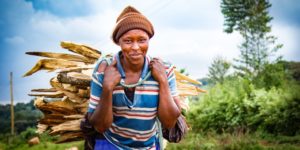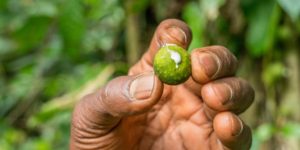
Nairobi dialogue cultivates answers on how to bring everyone to the restoration table.
Four East Africa country representatives, a handful of restoration implementers, half a dozen scientists and a collection of gender specialists walked into a room. They emerged hours later with points of action and vows to work together, after a day of discussions that focused on national-level forest restoration work, women’s rights to land and the gendered use of resources.
The dialogue on Forest Landscape Restoration (FLR) and gender equality in Nairobi, the second in a series of events on the topic hosted by the Center for International Forestry Research (CIFOR), together with the CGIAR Research Program on Forests, Trees and Agroforestry (FTA) and partners, delved into the East Africa experience with the aim to create integrated solutions.
Read more: Policy Dialogue on Forest Landscape Restoration and Gender Equality
“The discussion examined what restoration is on the ground and how different countries are implementing it, and about the challenges in terms of gender equality. FLR takes place in a context where inequalities exist and so the question is the way in which FLR is done – you can either reproduce or even exacerbate those inequalities if you’re not taking gender into account,” FTA and CIFOR research officer Markus Ihalainen said in an interview after the event.
With examples from Kenya, Ethiopia, Uganda and Tanzania presented along with the benefits of grounding gender equality in FLR — and the risks of not doing so — participants brainstormed and workshopped ways forward as restoration commitments around the world surge.
At the event, FTA and CIFOR’s Esther Mwangi said of equity guarantees, “It’s important to have things on paper, but we should not overestimate that […] It is not just about adding gender, but understanding gender across the different actors involved.”
Read more: FTA at Global Landscapes Forum Bonn
LET’S GET PRACTICAL

Daniel Nkondola from the Tanzania Vice President’s Office discussed the differing ways men and women use the country’s forests, with women’s roles restricted although they are considered the managers of resources, and men harvesting forest products for commercial activities.
“But female-headed households plant more trees than men,” he said, adding as a sort of call to action. “We know that women can be agents of change.”
In Ethiopia, mapping was front and center as Ashebir Wondimu from the Ministry of Environment talked restoration in the country, with work on the ground including agroforestry, reforestation and the establishment of enclosures.
When gender is thrown in the FLR mix, Wondimu said, “Existing policies, strategies, initiatives and targets encourage gender equality. The problem is the practice and the capacity to monitor its implementation.”
As the discussion moved toward strategically addressing gender issues, Janet Macharia of UN Environment said, “If you look at FLR you must look at a wider spectrum: you’re looking at sustainable livelihoods, you’re looking at water, you’re looking at energy, political issues, education […] so gender mainstreaming is exciting.”
And along with that wider perspective, one must also drill down to specificities, as many emphasized throughout the day.
Ihalainen said: “These issues need to be approached contextually. But it’s not only a national issue, as these things look differently even within a country depending on which area or region you’re in, or the cultural context. What is clear is that a lot of the challenges in terms of FLR are quite similar in these countries but the approaches are different.”
Read more: Focus on gender research and mainstreaming
LOST IN TRANSLATION
Along with the different approaches to FLR — which can vary by climate, region, nation or village – are the many different roles men and women play. In combination, this makes for heady layers of considerations.
Macharia said of indigenous knowledge, “The trees that women are allowed to cut, the trees that men are allowed to cut, the trees no one is allowed to cut that are used for medicine — these practices need to be brought into policy and the policy taken down to the ground.
“You can’t go places and talk gender and gender equality because people have no clue what that is, because you can’t translate that into their language. It is up to us to translate what it is we want to do and understand where they’re coming from and work for change. We have to put ourselves in their shoes.”

This need to translate gender and restoration with the people impacted most — through understanding, informing and doing — was a common thread in the day’s discussions.
“It’s a good exercise to think about how FLR could be done in a more holistic way and how gender features in that. But in the short term we need to look at what’s happening on the ground, what are the issues that are emerging, what are the risks and what’s the support that’s needed,” Ihalainen said.
“That’s what I’m hoping to bring to our upcoming discussion at the Global Landscapes Forum (GLF) in Bonn — a perspective that’s more than just talking about gender responsiveness as part of a theoretical concept that’s not necessarily being implemented in that way.”
This topic will be discussed at a session titled Enhancing tenure security and gender equality in the context of forest landscape restoration, which FTA is coorganizing, at the GLF.
GROUND UP
But what are the risks if restoration efforts continue without consideration of structural inequalities, or gendered labor, or property rights and women?
Mwangi said, “If we do not take into account gender in a meaningful way then there won’t be incentives for women to participate in restoration. There is the issue of tenure and rights in East Africa; in these countries women can be neglected. Ask who owns that tree, who owns this land — you are unlikely to hear that it’s a woman.
“Without women having tenure to trees or land or both it becomes really difficult for them to participate in tree planting. In Tanzania, for example, women plant trees but don’t have rights to land. Because of such issues we may not be able to realize the full potential of restoration.”
In a just-published brief on the topic, the authors wrote, “Lessons from past restoration efforts have shown that although women are mobilized to provide labor and skills for restoration initiatives, they usually have less ability to benefit than men.”
Read more: Gender matters in Forest Landscape Restoration: A framework for design and evaluation
One of the workshop participants, Komaza’s Janet Chihanga, provided a concrete example. Komaza is a forestry company that supports local women to plant trees on unused, degraded land in the coastal region of Kenya.
“When we planted the trees eight years ago, no one had any interest in this land. But now when it’s not even time for harvesting but just thinning, the men show up and assert their claims on the land,”, she said.
So solving the restoration riddle of gender-responsiveness means solving the ongoing issue of rights and tenure, as well as that of uneven duties of men and women, among many others.
“There’s a need for more innovative thinking, more innovative partnerships and more learning from good practices and things that have worked in certain contexts and trying to figure out if and how they would work in other contexts or tweaked somewhere else,” Ihalainen said.
This learning and working through innovations has just begun, and discussions of these key, intersecting issues will continue, with resolutions now that much closer.
Read more: Gender matters in forest landscape restoration infographic
By Deanna Ramsay, originally published at CIFOR’s Forests News.
For more information on this topic, please contact Markus Ihalainen at m.ihalainen@cgiar.org.
This research forms part of the CGIAR Research Program on Forests, Trees and Agroforestry, which is supported by CGIAR Fund Donors.
This research was supported by UK aid from the UK government.











